Archives
Month: January 2023

Regional Overview
September — December 2022Indo-Pacific as the “Epicenter”
The Biden administration released its long-awaited National Security Strategy (NSS) this reporting period, along with unclassified versions of its National Defense Strategy and Missile Defense and Nuclear Posture Reviews. There were no big surprises. The NSS identified the Indo-Pacific as “the epicenter of 21st century geopolitics” and reaffirmed China as the “pacing challenge,” even while branding Russia as “an immediate threat to the free and open international system” as a result of its invasion of Ukraine. Underscoring the priority attached to the region, President Biden attended the East Asia Summit in Phnom Penh and the G20 Summit in Bali, with Vice President Kamala Harris representing the United States at the annual Asia Pacific Economic Cooperation (APEC) Leaders’ Meeting in Bangkok. Kim Jong Un was not invited to any of the Asia summits but found other ways to attract attention, including some 70 ballistic missile launches for the year while announcing plans to rapidly produce and potentially use tactical nuclear weapons. Chinese President Xi Jinping, when not busy defending Pyongyang’s bad behavior, was busy orchestrating the 20th National People’s Congress, where he was elected “president for life.”

US - Japan
September — December 2022Ramping Up Diplomacy and Defense Cooperation
In the wake of the death of former Prime Minister Abe Shinzo, the fall brought unexpectedly turbulent politics for Prime Minister Kishida Fumio. In the United States, however, President Joe Biden welcomed the relatively positive outcome of the midterm elections, with Democrats retaining control over the Senate and losing less than the expected number of seats in the House. Diplomacy continued to be centered on various impacts of the Russian invasion of Ukraine, but both Biden and Kishida focused their attention on a series of Asian diplomatic gatherings to improve ties. Chinese President Xi Jinping’s attendance at the G20 Meeting in Bali and APEC gathering in Bangkok proffered the opportunity finally for in-person bilateral meetings for both leaders. Finally, Japan’s long awaited strategic documents were unveiled in December. A new National Security Strategy (NSS) took a far more sober look at China’s growing influence and included ongoing concerns over North Korea as well as a growing awareness of Japan’s increasingly difficult relationship with Russia.
Accompanying the NSS is a 10-year defense plan, with a five-year build-up commitment, that gave evidence that Kishida and his ruling coalition were serious about their aim to spend 2% of Japan’s GDP on its security. The desire for greater lethality was also there, with the inclusion of conventional strike investment.

US - China
September — December 2022The Bali Summit: US and PRC Leaders Attempt to Arrest the Slide
Joe Biden and Xi Jinping met in person for the first time as national leaders at the G20 summit in Bali and agreed to manage competition in their relationship responsibly and restore regular dialogue between senior officials and cooperation between their countries. Bilateral meetings between senior officials in charge of climate, finance, trade, and defense followed. After the US announced another weapons sale to Taiwan, however, Beijing halted the resumption of military-to-military exchanges again. The US issued new export controls aimed at freezing China’s advanced chip production and supercomputing capabilities. President Biden maintained that he would send US forces to defend Taiwan if attacked and repeated that whether the island is independent is up to Taiwan to decide. The Biden administration issued its National Security Strategy, National Defense Strategy, Nuclear Posture Review, and Missile Defense Review. The US imposed sanctions on Chinese officials for serious human rights abuses in Tibet and arbitrary detention of Falun Gong practitioners. China retaliated by sanctioning two former Trump administration officials.
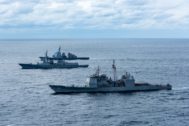
US - Korea
September — December 2022Everything Everywhere All at Once, Extremely Close and Incredibly Loud
Continuing a trend from the May-August reporting period, the final reporting period of 2022 in US-Korea relations was marked by an accelerated ratcheting up of tension. In short, numerous problems reared up on the Korean Peninsula from September-December, and good solutions have been few. And not only does this describe relations between the US and North Korea, but in their own, friendly way also the situation between Washington and Seoul, whose frequent invocations of rock-solid alliance cooperation belie unease about crucial areas of partnership.
Two critical issues have been increasingly affecting the US-South Korea alliance in 2022, with the September-December period no exception. First, South Korea desires ever more alliance-partner defense and security reassurance from the US in the face of a growing North Korean nuclear threat and Chinese revisionism. Yet the US has downward-trending limits on credible reassurance as North Korea masters nuclear weapons technology that threatens US extended nuclear deterrence for South Korea. The US also faces less geopolitical pressure to effusively reassure its Indo-Pacific allies—including South Korea—as China grows to menace the regional order and the US consequently faces lower risk of ally hedging or realignment.

US - India
September — December 2022Friends with Benefits
This chapter was made possible through a grant from the Hindu American Foundation
2022 was a challenging year, not just for US-India relations, but for every India analyst trying to explain the Indian government’s position on the Russia-Ukraine conflict. Explaining to a non-IR audience India’s history of nonalignment during the Cold-War era and its current policy of multi-alignment was not a gratifying endeavor. While the last four months of 2022 did not have the friction and stress-tests as the first four of 2022 or the slow and steady expansion of relations that followed between May and September, they certainly had multiple surprising events that could make them the halcyon months of 2022. In mid-November, the US and Indian armies engaged in a military exercise at Auli, not far from the Line of Actual Control (LAC) separating Indian-held and Chinese-held territory. While the US and Indian armies have engaged in exercises prior to 2022, this proximity to the Indo-China border is a first. A month later, in another first, US Treasury Secretary Janet Yellen traveled to India to meet Indian Finance Minister Nirmala Sitharaman to expand the US-India “Indo-Pacific partnership.” Yellen characterized India as a “friendly shore” for supply chain diversification and as the indispensable partner for the US.
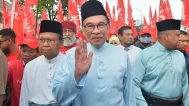
US - Southeast Asia
September — December 2022External Order, Inner Turmoil
In November three ASEAN states—Cambodia, Indonesia, and Thailand—drew favorable marks for their chairmanship of high-profile regional and global meetings: the East Asia Summit and ASEAN Leaders Meeting; the G20 Summit; and the Asia Pacific Economic Cooperation (APEC) meeting, respectively. Helming these meetings was particularly challenging for Southeast Asian leaders—who are naturally inclined to avoid strong alignments with external powers—in the current global environment of heightened tensions between the United States and China in the Taiwan Strait and the war in Ukraine. However, the year was a difficult period for ASEAN internally, with uneven economic recovery from the COVID-19 pandemic and the intractable conflict in Myanmar. The last quarter of 2022 saw two political shifts in the region: in general elections in Malaysia, Anwar Ibrahim achieved a longstanding ambition to become prime minister but will have to manage a difficult coalition to retain power. At the year’s end, Laos changed prime ministers, but it is not clear if the transition will solve the country’s debt problems, which were revealed to be more dire than estimated.
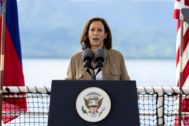
China - Southeast Asia
September — December 2022Xi Moderates to US and Others Amid Continued Competition
Southeast Asia was the center of international attention in November as regional and global leaders gathered at the G20 conference in Indonesia, which took place between the annual ASEAN-hosted summit meetings in Cambodia and the yearly APEC leaders meeting in Thailand. Acute China-US rivalry loomed large in media and other forecasts, warning of a clash of US-Chinese leaders with negative implications feared in Southeast Asia and elsewhere. The positive outcome of the Biden-Xi summit at the G20 conference and related actions eased tensions, which was welcomed, particularly in Southeast Asia, but the implications for the US and allies’ competition with China remain to be seen. Tensions over disputes in the South China Sea continued unabated. President Xi Jinping made his first trip to a major international gathering at the G20 conference followed by the APEC meeting after more than two years of self-imposed isolation in line with his government’s strict COVID-19 restrictions.
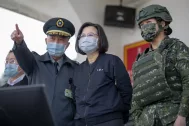
China - Taiwan
September — December 2022Tensions Intensify as Taiwan-US IT Cooperation Blossoms
In the wake of then US Speaker of the House Nancy Pelosi’s visit to Taiwan in August, China’s extensive military exercises continued to impose a more threatening “new normal” in the Taiwan Strait. Taiwan continued to be the focus of heated public exchanges between the US and China. US President Biden said, for a fourth time, that the US would defend Taiwan and added an inflammatory codicil that independence was for Taiwan to decide. At the 20th Congress of the Chinese Communist Party, General Secretary Xi Jinping promised China would strive for peaceful reunification with Taiwan but would not renounce use of force. On Dec. 23, Biden signed the Taiwan Enhanced Resilience Act and a State Department appropriation providing $2 billion in loans for Taiwan to purchase US equipment. Two days later, China sent 71 military aircraft and seven ships to intimidate Taiwan, its largest-ever one-day exercise near the island. Two days later, Taiwan President Tsai Ing-wen announced that Taiwan would extend its military conscription to 12 months. TSMC formally broke ground for the first of two factories in the US, a $40 billion investment.
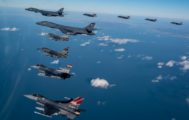
North Korea - South Korea
September — December 2022Drones in a Darkening Sky, Tactical Nuke Talk: Pyongyang’s Provocations Escalate
The main feature of inter-Korean relations in the last four months of 2022 was varied and ever-increasing provocations by Pyongyang. Besides multiple missiles, there were artillery volleys and an incursion by five drones. Kim Jong Un also ramped up his nuclear threats, in theory and practice. A revised law widened the scope of nuclear use, while a new stress on tactical weapons was matched by parading 30 new multiple launch rocket systems (MLRs) which could deliver these anywhere on the peninsula. The government of South Korean President Yoon Suk Yeol for his part reinstated officially calling North Korea an enemy, and revived concern with DPRK human rights. As the year turned, his government was mulling retaliation for the drone incursions; that could include scrapping a 2018 inter-Korean military accord, a dead letter now due to Pyongyang’s breaches. With tensions rising, the new year ahead may be an anxious one on the peninsula.
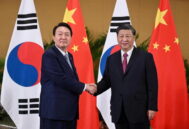
China - Korea
September — December 2022Kim Jong Un Tests Xi-Yoon Diplomacy
Regional and global summits presented high-level platforms for China-South Korea engagement in November. The summitry showed that the relationship had returned with solidity with the resumption of international meetings and in-person exchanges. Although the Xi Jinping and Yoon Suk Yeol leaderships advanced diplomatic exchange, concerns emerged over enduring political and security constraints and growing linkages with the economic relationship. Kim Jong Un’s escalation of military threats, through an unprecedented number of missile tests this year, challenged Xi-Yoon bilateral and multilateral diplomacy. China-North Korea bilateral interactions, while brisk, primarily relied on Xi and Kim’s exchange of congratulatory letters around significant founding anniversaries, China’s 20th Party Congress, and expressions of condolences after the death of former Chinese leader Jiang Zemin. The UN Security Council’s failure to take unified action on DPRK threats prompted South Korea to voice frustration with China and expand cooperation with US and Japanese partners. Such responses only reinforced concerns raised in recent leadership exchanges, and Korean domestic division over Yoon’s diplomatic strategies.